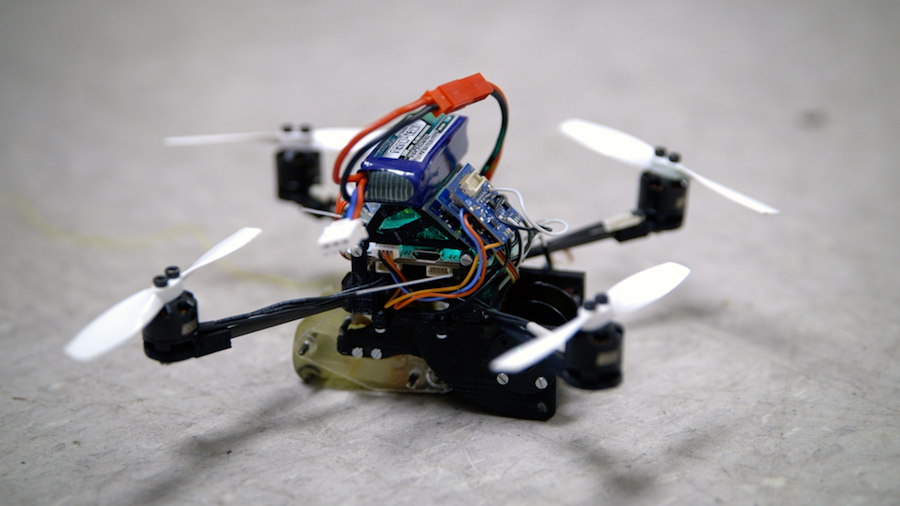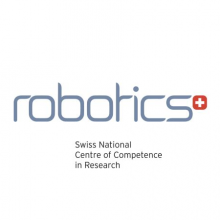
Robohub.org
Small flying robots able to pull objects up to 40 times their weight

Researchers from EPFL and Stanford have developed small drones that can land and then move objects that are 40 times their weight, with the help of powerful winches, gecko adhesives and microspines.
A closed door is just one of many obstacles that no longer pose a barrier to the small flying robots developed jointly by Ecole Polytechnique Fédérale de Lausanne (EPFL) and Stanford University. Equipped with advanced gripping technology – inspired by gecko and insect feet – and able to interact with the world around them, these robots can work together to lasso a door handle and tug the door open.
These FlyCroTugs – flying, micro, tugging robots – came out of the laboratories run by Dario Floreano, NCCR Robotics Director, at EPFL’s School of Engineering, and Mark Cutkosky, the Fletcher Jones Chair in the School of Engineering at Stanford University.
FlyCroTugs are micro air vehicles that the researchers modified so that they can anchor themselves to various surfaces using gecko adhesives and microspines. Thanks to these mechanisms, FlyCroTugs can pull objects up to 40 times their weight, such as door handles or, in a rescue scenario, cameras and water bottles. Similar vehicles produced by other researchers can tug objects only about twice their weight.
“When you’re a small robot, the world is full of large obstacles,” says Matthew Estrada, a graduate student at Stanford. Estrada worked on this project in Floreano’s Laboratory of Intelligent Systems (LIS) at EPFL and is the lead author of a paper published in Science Robotics. “By combining the aerodynamic forces of our vehicle and the interactive forces generated by the attachment mechanisms, we were able to come up with something that is very mobile, very strong and very small.”
The researchers note that the FlyCroTugs, because of their size, can safely navigate through tight spaces and fairly close to people. This makes them a good candidate for search and rescue missions. And by holding on tightly to surfaces as they tug, the tiny robots could potentially move pieces of debris or position a camera to evaluate a dangerous situation.
Taking a cue from nature
FlyCroTugs were inspired by nature. When the researchers began working on an air vehicle that would be fast, small, highly maneuverable and able to move large loads, they first looked at wasps.
“Wasps fly quickly to a piece of food, and if it’s too heavy to carry off, they drag it along the ground. This observation was the genesis of our approach,” said Cutkosky, a co-author of the paper.
By analyzing studies on how wasps capture and transport prey, the researchers were able to identify the ratio of flight-related muscle to total mass that determines whether a wasp carries its prey or drags it. Wasps also inspired them to develop various attachment options depending on where the FlyCroTugs land. For smooth surfaces, the robots have gecko grippers, a non-sticky adhesive that mimics a gecko’s intricate toe structures. They hold on by creating intermolecular forces between the adhesive and the surface.
For rough surfaces, these robots are equipped with 32 microspines, a series of fish-hook-like metal spikes that can individually latch onto small pits in a surface. In order to tug a payload, each FlyCroTug has a winch with a cable and either microspines or gecko grippers. Those are its only fixed features; the rest are highly modifiable. The location of the grippers can be moved, depending on the expected landing surface, and the researchers can add parts – such as wheels – for ground locomotion. Packing all these features onto a small air vehicle that weighs just a few ounces was not easy.
“People tend to think of drones as machines that fly and observe the world. But flying insects do many other things, such as walking, climbing, grasping and building. Social insects can even work together and combine their strength,” says Floreano, the study’s lead senior author. “Through our research, we show that small drones are capable of anchoring themselves to surfaces around them and cooperating with fellow drones. This enables them to perform tasks typically assigned to humanoid robots or much larger machines.”
Interacting with the world
At a time when drones and other small flying robots are all the rage, the FlyCroTugs – with their ability to perch, climb, push and pull – really stand out, according to Cutkosky. Using two FlyCroTugs, the researchers were able to open a door. They also had one of them haul a camera to the top of a crumbling structure to peer inside. Next, they hope to work on autonomous control and the logistics of flying several vehicles at once.
This work was funded by the Swiss National Science Foundation (SNSF), the National Centre for Competence in Research (NCCR) Robotics, and the United States Army Research Laboratory MAST program.
Useful links:
Reference: M. A. Estrada, S. Mintchev, D. Christensen, M. R. Cutkosky, D. Floreano, “Forceful Manipulation with Micro Air Vehicles”, Science Robotics.
tags: herotagrc



